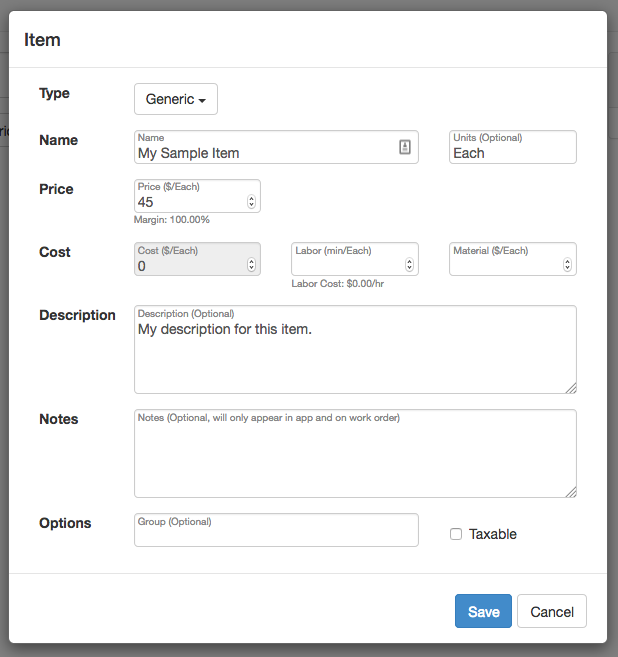Items and services can be pre made and stored in your Item List to be used on future projects. This reduces the time it takes you to make your estimates by saving you the time of having to type out the name, description, and other information each time you create your estimates.
1.) Go to Settings>Item List from the top menu.
2.) Select the + Item button to make a new item.
3.) Fill in the details for the item:
- Type - Items can be categorized as Generic, Labor, Material, or Assembly. (More information below)
- Name - A descriptive name for the item or service.
- Unit - This will be how the item is quantified. (Ex. Hours, Each, Pounds, Gallons, etc.)
- Price - The price for one unit of this item.
- Cost - Enter in the labor and material cost per unit of this item if it has one. (Only available in Enterprise)
- Description - A summary of the item or service.
- Notes - The notes will appear below the line item description and are only be visible on work orders.
- Group - The name of the group the item will be placed in.
- Taxable - The item can automatically be marked as taxed if selected.
4.) Save when finished.

Item Types
Item types give different attributes to your items for different uses.
Generic
A normal item or service that has no special attributes.

Labor
A labor item is used for services that you would estimate and bill by the hour. Labor items used on a project will accumulate a labor total that the customer will not see but which will be available on work orders to show how many hours that service is expected to take.
You will want to enter the Price you charge your customers per hour into the Price field. The Unit defaults to Hours for a labor item.

Material
A material item is used for materials that will be needed for the service you are estimating for your customer. Material items will also create a materials list that the customer will not see but which will be available for work orders to identify the various materials needed for the project. This can be used for picking project from the warehouse or for ordering from a supplier for the project.
You will want to enter the retail price for the material in the Price field. In the Unit field enter the unit size that you buy the item in. Example: GAL or SET or BAG depending upon the material.

Assembly
Assembly items can combine one or more material and labor items. For example, if you are painting the walls in a room, you would probably want to enter the number of square feet in the room and have Estimate Rocket calculate the price of the material and labor time from the square feet.
Assembly items allow you to enter the production rate and material usage rates for the items you add to the assembly. For example when you enter your labor item, you might enter 300 as the SQFT/HOUR that your painter can paint. When you enter the material item for the paint, you might enter 350 SQFT/GAL. By adding all of the Labor and Material items you need for your Assembly (Paint Walls) you will see that a Unit Price for that service is calculated for you that includes both Labor and Materials.
